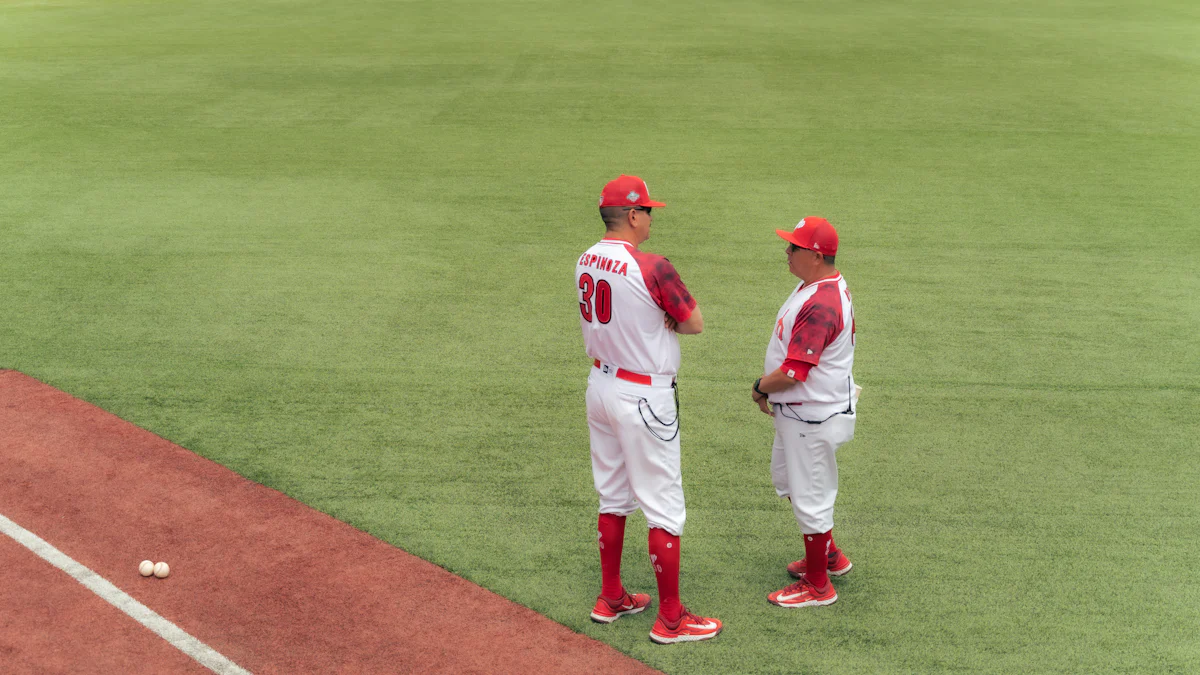
In baseball, WHIP, or Walks plus Hits per Inning Pitched, is a vital statistic that evaluates a pitcher’s effectiveness in controlling the game. Known as baseball WHIP, it measures the number of base runners a pitcher allows per inning by combining walks and hits into one comprehensive metric. A lower baseball WHIP signifies dominance on the mound, with values under 1.00 regarded as exceptional. Iconic pitchers like Pedro Martínez and Clayton Kershaw have consistently maintained low WHIPs, demonstrating their remarkable precision and control. By focusing on reducing your baseball WHIP, you can minimize scoring opportunities for opponents and greatly enhance your team’s overall performance.
Key Takeaways
Understanding WHIP is crucial for pitchers; it measures the number of base runners allowed per inning, combining walks and hits into one metric.
A lower WHIP indicates better control and effectiveness on the mound, reducing scoring opportunities for opponents.
To lower your WHIP, focus on improving your control to minimize walks by mastering the strike zone and refining your pitching mechanics.
Refine your pitch selection by studying batter tendencies and mixing pitches effectively to limit hits.
Enhance your mental focus during games by staying calm under pressure and using visualization techniques to improve accuracy.
Incorporate targeted drills and exercises into your training routine to build accuracy and consistency in your pitching mechanics.
Regularly track your WHIP progress and celebrate improvements to stay motivated and committed to mastering your pitching skills.
Understanding Baseball WHIP and Its Importance

What is WHIP and How is it Calculated?
WHIP, short for Walks plus Hits per Inning Pitched, is a straightforward yet powerful statistic in baseball. It measures how many base runners you allow per inning by combining the total number of walks and hits you give up. To calculate WHIP, divide the sum of walks and hits by the total innings you pitch. For example, if you allow 10 walks and 20 hits over 30 innings, your WHIP would be 1.00. This metric provides a clear picture of your ability to control the game by keeping runners off base.
Unlike other statistics, such as ERA (Earned Run Average), WHIP focuses solely on base runners rather than runs scored. This makes it an essential tool for evaluating your effectiveness against individual batters. A lower WHIP indicates fewer base runners, which directly reduces scoring opportunities for the opposing team. By understanding and tracking your WHIP, you can identify areas for improvement and work toward becoming a more dominant pitcher.
Why WHIP is a Key Metric for Pitchers
WHIP stands out as one of the most reliable indicators of a pitcher’s performance. It reflects your ability to prevent hitters from reaching base, which is critical for maintaining control over the game. A low WHIP often correlates with success on the mound, as it shows that you consistently limit scoring chances for the opposing team.
This statistic also provides a more comprehensive view of your skills compared to traditional metrics. While ERA measures the runs you allow, WHIP focuses on the frequency of base runners, offering a clearer picture of your consistency. For example, even if you have a low ERA, a high WHIP might suggest that you frequently allow runners but rely on your defense to prevent them from scoring. By prioritizing a lower WHIP, you can take greater control of the game and reduce reliance on external factors like defensive plays.
The Impact of Walks and Hits on WHIP
Walks and hits are the two components that directly influence your WHIP. Each walk or hit you allow increases the number of base runners, which raises your WHIP and gives opponents more chances to score. Walks, in particular, can be especially damaging because they result from a lack of control. By improving your command of the strike zone, you can minimize unnecessary walks and keep your WHIP in check.
Hits, on the other hand, often depend on factors like pitch selection and location. Poorly placed pitches or predictable patterns can make it easier for batters to connect and reach base. To limit hits, focus on mixing your pitches and targeting specific areas of the strike zone. Additionally, a strong defensive team can help reduce the impact of hits by turning potential base hits into outs.
By addressing both walks and hits, you can significantly lower your WHIP and enhance your overall effectiveness as a pitcher. This not only improves your individual performance but also strengthens your team’s chances of success.
Strategies to Reduce Baseball WHIP
Improving Control to Minimize Walks
Mastering the Strike Zone
To lower your baseball WHIP, you must first master the strike zone. Understanding its dimensions and how umpires interpret it can give you a significant edge. Focus on consistently throwing strikes in areas where batters are less likely to make solid contact. Practice targeting the corners of the zone to keep hitters guessing. This approach reduces the likelihood of walks while increasing your chances of inducing weak contact.
Developing Consistent Pitching Mechanics
Consistency in your pitching mechanics is essential for improving control. Repetition builds muscle memory, which allows you to deliver pitches with precision. Work on maintaining a steady release point and balanced posture throughout your motion. Coaches often emphasize drills that reinforce these mechanics, such as throwing from a flat surface or using video analysis to identify flaws. By refining your mechanics, you can minimize erratic pitches that lead to unnecessary walks.
Using Visualization Techniques for Accuracy
Visualization can enhance your accuracy on the mound. Before each pitch, picture the ball traveling to your intended target. Imagine the batter’s reaction and the outcome you want to achieve. This mental rehearsal sharpens your focus and helps you execute pitches with greater precision. Many elite pitchers use this technique to stay locked in during high-pressure situations. Incorporating visualization into your routine can significantly improve your control and reduce your baseball WHIP.
Refining Pitch Selection to Limit Hits
Understanding Batter Tendencies
Studying batter tendencies is a critical step in limiting hits. Analyze their strengths, weaknesses, and preferred zones. Pay attention to how they react to different pitch types and speeds. For example, some hitters struggle with breaking balls low in the zone, while others excel at hitting fastballs up high. Use this knowledge to craft a game plan that exploits their vulnerabilities. By keeping hitters off balance, you can reduce the number of hits you allow.
Mixing Pitches Effectively
Effective pitch mixing keeps batters guessing and prevents them from timing your delivery. Alternate between fastballs, breaking balls, and off-speed pitches to disrupt their rhythm. Avoid falling into predictable patterns, as experienced hitters can capitalize on repeated sequences. Instead, vary your pitch selection based on the count and game situation. This strategy not only limits hits but also enhances your overall effectiveness on the mound.
Prioritizing Location Over Velocity
While velocity can be an asset, location often matters more when it comes to reducing hits. A well-placed pitch on the edges of the strike zone is harder to hit than a fastball down the middle. Focus on hitting your spots rather than trying to overpower every batter. Precision pitching forces hitters to chase difficult pitches, leading to weak contact or swings and misses. By prioritizing location, you can lower your baseball WHIP and improve your performance.
Enhancing Mental Focus During Games
Staying Calm Under Pressure
Pressure situations can test your mental toughness. Staying calm on the mound helps you maintain control and execute pitches effectively. Develop strategies to manage stress, such as taking deep breaths or stepping off the rubber to reset. Remember that even the best pitchers face adversity. Keeping your composure allows you to focus on the next pitch rather than dwelling on past mistakes.
Building Confidence Through Preparation
Preparation breeds confidence. Study scouting reports, practice your mechanics, and refine your pitch selection before each game. The more prepared you feel, the more confident you’ll be in your abilities. Confidence translates to better decision-making and execution on the mound. When you trust your skills, you’re less likely to make mistakes that lead to walks or hits.
Using Breathing Techniques to Stay Composed
Controlled breathing can help you stay composed during intense moments. Take slow, deep breaths to calm your nerves and regain focus. This simple technique reduces tension and improves your ability to concentrate. Many professional pitchers use breathing exercises to stay in control during high-stakes situations. Incorporating this habit into your routine can enhance your mental focus and contribute to a lower baseball WHIP.
Drills and Training Methods to Improve Baseball WHIP

Drills for Pitching Accuracy
Target Practice Drills
Target practice drills sharpen your ability to hit specific spots in the strike zone. Set up targets, such as small cones or zones marked on a net, and aim for them during your practice sessions. Focus on hitting the corners of the strike zone, as these areas are harder for batters to reach. Gradually increase the difficulty by reducing the size of the target or varying the distance. This drill builds precision and helps you consistently throw strikes, which directly lowers your WHIP.
Bullpen Sessions with Focus on Strike Percentage
Bullpen sessions provide an excellent opportunity to refine your control. During these sessions, track your strike percentage by counting how many pitches land in the strike zone. Set a goal to improve this percentage over time. Work with a coach or teammate to simulate game scenarios, such as pitching with runners on base or facing a full count. These focused sessions help you develop the consistency needed to minimize walks and maintain a low WHIP.
Exercises for Consistent Mechanics
Balance and Core Strength Workouts
Balance and core strength play a crucial role in maintaining consistent mechanics. Incorporate exercises like planks, medicine ball twists, and single-leg squats into your training routine. These workouts strengthen your core and improve your stability on the mound. A strong core allows you to generate power and control your movements, reducing the likelihood of erratic pitches that lead to walks or hits.
Repetition Drills for Muscle Memory
Repetition drills reinforce proper mechanics through consistent practice. Perform drills that focus on your pitching motion, such as throwing from a flat surface or using a towel drill to simulate your arm action. Repeat these drills daily to build muscle memory. Over time, your body will naturally replicate the correct mechanics during games, leading to improved accuracy and a lower WHIP.
Mental Training Techniques
Visualization and Mental Rehearsal
Visualization enhances your mental preparation and focus. Before stepping onto the mound, close your eyes and picture yourself executing perfect pitches. Imagine the ball hitting the target and the batter swinging and missing. This mental rehearsal boosts your confidence and helps you stay locked in during games. Many successful pitchers use visualization to prepare for high-pressure situations and maintain control.
Mindfulness Exercises for Focus
Mindfulness exercises improve your ability to stay present and focused. Practice techniques like deep breathing or meditation to calm your mind before and during games. For example, take a few moments between pitches to focus on your breath and reset your thoughts. These exercises reduce distractions and help you concentrate on executing each pitch. By staying mentally sharp, you can make better decisions and maintain a low WHIP.
WHIP remains a vital measure of your effectiveness as a pitcher. A lower WHIP reflects your ability to keep runners off base, reducing scoring opportunities for opponents and showcasing your control and efficiency. To achieve this, focus on three key strategies:
Improve control to minimize walks.
Refine pitch selection to limit hits.
Enhance mental focus to stay composed under pressure.
Track your progress consistently and celebrate small victories along the way. Commit to these improvements, and you’ll see steady growth in your performance. Remember, every step forward brings you closer to mastering the art of pitching.
FAQ
What does WHIP mean in baseball, and how does it impact a pitcher’s career?
WHIP, which stands for Walks plus Hits per Inning Pitched, measures how effectively you keep runners off base. It reflects your ability to control the game and limit scoring opportunities for the opposing team. A lower WHIP showcases your precision and efficiency on the mound. Coaches and managers often use this metric to evaluate your performance, decide your role in the team, and determine areas where you can improve.
Why is WHIP important for evaluating pitcher performance?
WHIP provides a clear picture of your consistency and control as a pitcher. Managers rely on this statistic to make critical decisions, such as who starts games or pitches in high-pressure situations. A low WHIP signals reliability, making you a valuable asset to your team. Conversely, a high WHIP may indicate areas where you need to refine your skills, such as improving control or pitch selection.
What’s considered a good WHIP in Major League Baseball?
In Major League Baseball, a WHIP below 1.20 is generally regarded as excellent. Achieving this level demonstrates your ability to consistently limit base runners and maintain control over the game. Many elite pitchers strive for a WHIP under 1.00, which signifies exceptional dominance on the mound.
How does WHIP differ from ERA?
WHIP and ERA (Earned Run Average) measure different aspects of your performance. WHIP focuses on the number of base runners you allow per inning, while ERA calculates the average number of earned runs you give up per nine innings. WHIP highlights your ability to prevent hitters from reaching base, whereas ERA reflects how well you minimize scoring. Together, these metrics provide a comprehensive view of your effectiveness as a pitcher.
Can WHIP impact fantasy baseball rankings?
Yes, WHIP plays a significant role in fantasy baseball. It combines walks and hits into a single metric, offering a detailed measurement of your efficiency. Fantasy baseball managers often prioritize pitchers with low WHIPs because they contribute to better overall team performance. A strong WHIP can boost your value in fantasy leagues and make you a sought-after player.
How can I lower my WHIP as a pitcher?
To lower your WHIP, focus on improving control to reduce walks and refining pitch selection to limit hits. Practice drills that enhance accuracy, such as target practice and bullpen sessions. Strengthen your mechanics through balance and core workouts. Additionally, develop mental strategies like visualization and mindfulness to stay composed during games. Consistent effort in these areas will help you achieve a lower WHIP.
Does WHIP account for defensive plays?
No, WHIP does not directly account for defensive plays. It solely measures the walks and hits you allow per inning. However, a strong defensive team can indirectly support a lower WHIP by turning potential hits into outs. While your performance is the primary factor, having reliable fielders behind you can enhance your overall effectiveness.
Is WHIP relevant for all levels of baseball?
Yes, WHIP is a valuable metric at every level of baseball, from youth leagues to the Major Leagues. It provides a straightforward way to assess your ability to control the game and limit base runners. Whether you’re a beginner or a seasoned player, tracking your WHIP can help you identify strengths and areas for improvement.
How does WHIP influence a pitcher’s role on the team?
A low WHIP often earns you trust from coaches and teammates. It shows that you can consistently keep runners off base, making you a reliable option in critical situations. Pitchers with strong WHIPs are more likely to start games, close out innings, or pitch in high-pressure scenarios. Conversely, a high WHIP may lead to adjustments in your role or additional training to address weaknesses.
Can WHIP fluctuate during a season?
Yes, WHIP can fluctuate throughout a season based on your performance. Factors like control, pitch selection, and game conditions can influence your WHIP. Regularly reviewing your stats and making adjustments will help you maintain a consistent and competitive WHIP. Tracking your progress allows you to stay focused on improvement and achieve long-term success.
